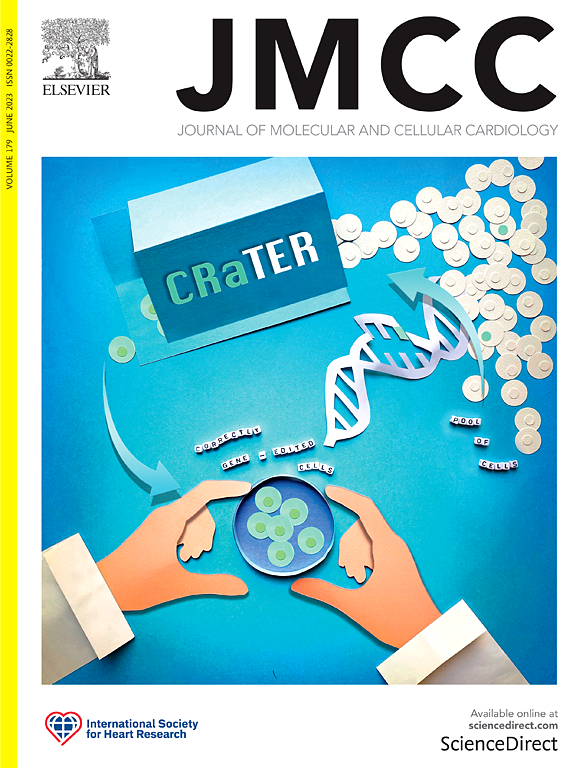Uncoupling protein 3 protects against pathological cardiac hypertrophy via downregulation of aspartate
IF 4.7
2区 医学
Q1 CARDIAC & CARDIOVASCULAR SYSTEMS
引用次数: 0
Abstract
Metabolic remodeling involving alterations in the substrate utilization is a key feature of cardiac hypertrophy. However, the molecular mechanisms underlying regulation of tricarboxylic acid cycle intermediates by mitochondrial membrane proteins during cardiac hypertrophy have not yet been fully clarified. Mitochondrial uncoupling protein 3 (UCP3), an anion transporter located on the inner mitochondrial membrane, exerts cardioprotective effects against ischemia/reperfusion injury and its insufficiency exacerbates left ventricular (LV) diastolic dysfunction during hypertension. However, its role in pressure overload-induced cardiac hypertrophy remains unknown. Here, we found that UCP3 was downregulated in the mouse LV with transverse aortic constriction (TAC)-induced pathological hypertrophy and in phenylephrine (PE)-stimulated hypertrophic neonatal rat cardiomyocytes (NRCMs). The TAC-induced hypertrophy and LV dysfunction were aggravated in global and cardiac specific knockout of UCP3 (UCP3cKO) mice but improved by cardiac specific overexpression of UCP3 (UCP3cOE). Similar alterations in hypertrophy were observed in PE-treated NRCMs with UCP3-knockdown/overexpression. Moreover, the TAC-increased aspartate and glutamic-oxaloacetic transaminase 2 (GOT2) activity were enhanced in UCP3cKO hearts but reversed in UCP3cOE ones. PE-induced increases of GOT2 activity were enhanced in the UCP3-knockdown NRCMs but attenuated in the UCP3 overexpression ones, accompanied with the downregulation of aspartate. The endogenous interaction of UCP3 and GOT2 was weakened in the PE-treated NRCMs compared with the PE-untreated cells. Furthermore, aspartate supplementation reversed the UCP3 overexpression-attenuated hypertrophy in the PE-stimulated NRCMs. In conclusion, UCP3 expression is downregulated in hypertrophic hearts and cardiomyocytes, whereas the increase of UCP3 mitigates cardiac hypertrophy by downregulation of the enhanced aspartate. These findings provide new knowledge for the function of UCP3 and therapeutic target for cardiac hypertrophy.

解偶联蛋白3通过下调天冬氨酸抑制病理性心肌肥厚。
涉及底物利用改变的代谢重塑是心脏肥厚的一个关键特征。然而,心肌肥厚过程中线粒体膜蛋白调控三羧酸循环中间体的分子机制尚未完全阐明。线粒体解偶联蛋白3 (Mitochondrial uncoupling protein 3, UCP3)是一种位于线粒体内膜上的阴离子转运蛋白,对缺血/再灌注损伤具有心脏保护作用,其功能不足会加重高血压患者左室舒张功能障碍。然而,其在压力超载引起的心脏肥厚中的作用尚不清楚。在这里,我们发现UCP3在横断主动脉收缩(TAC)诱导的病理性肥厚的小鼠左心室和苯肾上腺素(PE)刺激的肥厚新生大鼠心肌细胞(NRCMs)中下调。在UCP3 (ucp3ko)的整体敲除和心脏特异性敲除小鼠中,tac诱导的肥厚和左室功能障碍加重,而在心脏特异性过表达UCP3 (UCP3cOE)小鼠中,tac诱导的左室功能障碍得到改善。在pe处理过ucp3敲低/过表达的nrcm中,也观察到类似的肥大变化。此外,tac增加的天冬氨酸和谷草转氨酶2 (GOT2)活性在UCP3cKO心脏中增强,而在UCP3cOE心脏中逆转。pe诱导的GOT2活性升高在UCP3敲低的nrcm中增强,而在UCP3过表达的nrcm中减弱,同时伴有天冬氨酸的下调。与未处理的细胞相比,pe处理的nrcm中UCP3和GOT2的内源性相互作用减弱。此外,补充天冬氨酸逆转了pe刺激的nrcm中UCP3过表达减弱的肥大。综上所述,在肥厚的心脏和心肌细胞中,UCP3的表达下调,而UCP3的增加通过下调增强的天冬氨酸来减轻心脏肥厚。这些发现为进一步了解UCP3的功能和心脏肥厚的治疗靶点提供了新的认识。
本文章由计算机程序翻译,如有差异,请以英文原文为准。
求助全文
约1分钟内获得全文
求助全文
来源期刊
CiteScore
10.70
自引率
0.00%
发文量
171
审稿时长
42 days
期刊介绍:
The Journal of Molecular and Cellular Cardiology publishes work advancing knowledge of the mechanisms responsible for both normal and diseased cardiovascular function. To this end papers are published in all relevant areas. These include (but are not limited to): structural biology; genetics; proteomics; morphology; stem cells; molecular biology; metabolism; biophysics; bioengineering; computational modeling and systems analysis; electrophysiology; pharmacology and physiology. Papers are encouraged with both basic and translational approaches. The journal is directed not only to basic scientists but also to clinical cardiologists who wish to follow the rapidly advancing frontiers of basic knowledge of the heart and circulation.

 求助内容:
求助内容: 应助结果提醒方式:
应助结果提醒方式:


